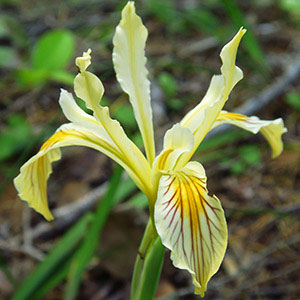Iris bracteata
Iris douglasiana
Siskiyou iris
Douglas' iris, mountain iris
sheathed with old leaf bases, slender, 0.6–0.9 cm diam.;
roots few, fibrous.
freely branching, forming large colonies, slender, 0.8–0.9 cm diam., covered with remains of old leaves;
roots fibrous.
simple, solid, 1.5–3 dm.
1–4-branched, solid, 1.5–7 dm.
basal with abaxial surface of blades deep glossy green on one side of fan, light yellow-green on other side, pink or red-tinged basally, strongly ribbed, 4–6 dm × 0.8–1 cm, rigid, margins not thickened;
cauline 3–6, imbricated, closely sheathing stem ca. 2/3 length, spreading distally, bractlike, blade inflated, often shorter than basal leaves.
basal with blade yellow-green, occasionally darker green, sometimes flushed pink or red basally, prominently ribbed, linear, 4.5–10 dm × 2 cm, apex acute;
cauline 1–3, reduced.
simple, units 1–2-flowered;
spathes closed tightly around pedicel and ovary, lanceolate, 5.2–9 cm × 6–8 mm, subequal, herbaceous, margins scarious, apex acuminate.
(2–)3-flowered, branch units 2–3-flowered;
spathes opposite or separated, divergent, green, sometimes flushed purple basally, lanceolate-acuminate, 6–12 cm × 7–12 mm.
perianth cream to buff-yellow;
floral tube 0.8–0.9 cm;
sepals with deeper yellow signal, veined with purple or brown, obovate-lanceolate, 6.5 × 2.5 cm, base gradually attenuate into wide claw;
petals narrowly oblanceolate, 7–9 × 0.8–2 cm, base gradually attenuate;
ovary nearly circular in cross section, 1.5–2.5 cm, base gradually attenuate into pedicel, apex abruptly acuminate into floral tube;
style 2.2–3 cm, crests spreading, yellow, not veined, 1.2 × 0.9–1.7 cm, margins toothed;
stigmas triangular or tongue-shaped, margins entire;
pedicel 3–6.2 cm.
perianth deep red-purple, lavender, gray-blue, cream, or white, with gold signal and blue or purple veins;
floral tube 1.5–2.8 cm, usually widening to bowl shape at base of flower;
sepals oblanceolate to obovate, 5–9 × 1.4–3 cm, base gradually attenuate, apex obtusely rounded;
petals oblanceolate, 4.5–7 × 0.9–1.8 cm, base attenuate to narrow claw;
ovary elliptic-oval, sharply triangular in cross section, 3–4 cm;
style 1.7–3.5 cm;
crests overlapping, subquadrate, 1–2 cm, margins coarsely toothed;
stigmas triangular;
pedicel 2–5 cm.
nearly circular in cross section, tapering abruptly at each end, 2–2.5 × 1–1.5 cm.
sharply triangular in cross section with ridge at each angle, tapering at both ends, remnant of floral tube forming tip at apex, 2.5–5 cm.
dark brown, irregular in shape, wrinkled.
dark brown, pyriform, wrinkled.
= 40.
= 40.
Iris bracteata
Iris douglasiana
Iris bracteata is limited to one county each in northern California and southern Oregon. It hybridizes with I. chrysophylla, I. douglasiana, I. innominata, I. munzii, I. purdyi, and I. tenax.
(Discussion copyrighted by Flora of North America; reprinted with permission.)
R. C. Foster (1937) named several varieties of Iris douglasiana, about which L. W. Lenz (1954) said, “This is a widespread and extremely variable species whose total variability is being increased due to introgressive hybridization between it and other species with which it has come into contact. Well marked and distinct geographic races cannot be detected; however, pronounced variations are to be found within a single population. For these reasons no attempt is made here to segregate taxa within such a polymorphic species.”
Iris douglasiana hybridizes with I. bracteata, I. chrysophylla, I. fernaldii, I. hartwegii, I. innominata, I. macrosiphon, I. munzii, I. purdyi, I. tenax, and I. tenuissima. The natural hybrid between I. douglasiana and I. innominata has been designated as Iris ×thompsonii R. C. Foster and the garden hybrid as Iris ×aureonympha E. H. English.
(Discussion copyrighted by Flora of North America; reprinted with permission.)


